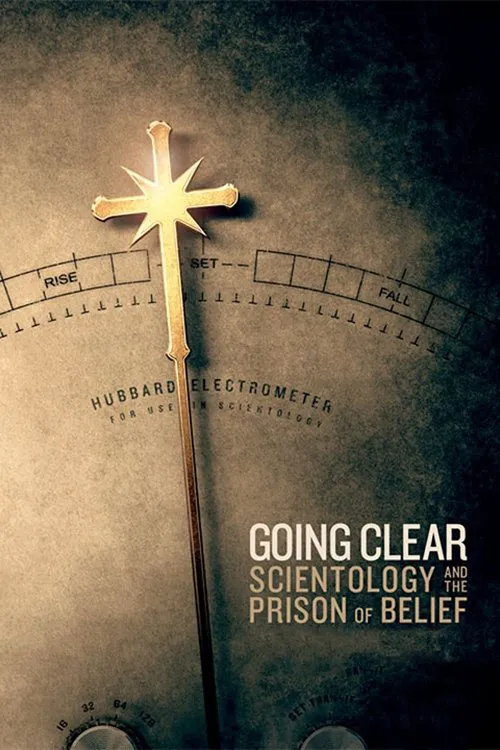Going Clear: Scientology and the Prison of Belief

Plot
Going Clear: Scientology and the Prison of Belief is a thought-provoking documentary that delves into the life of the Church of Scientology, a self-proclaimed spiritual movement created by science fiction author L. Ron Hubbard in the 1950s. The film, directed by Alexandre Goncalves and Alex Gibney, offers an intimate look at the lives of eight former members who have escaped the clutches of the church, shedding light on its tactics, secrets, and the psychological manipulation of its devotees. The documentary begins with an introduction to the core principles of Scientology, which revolves around the concept of the "thetan" – the true self or spiritual being. According to Hubbard, the thetan is trapped in the mortal realm due to past traumas and experiences, leading to a series of reincarnations. Through the practice of Dianetics, a self-help system developed by Hubbard, individuals can tap into their thetan and free themselves from these entrapments, thereby achieving spiritual liberation. As the film progresses, the spotlight turns to the lives of eight former members, each with a unique story to share. One of the most poignant stories belongs to Mike Rinder, a high-ranking executive within the Church of Scientology who rose through the ranks to become its European spokesperson. However, disillusionment and the discovery of internal corruption and financial deceit led Rinder to defect from the church, marking the beginning of a courageous journey toward exposing its dark secrets. The film also profiles Marty Rathbun, another high-ranking member who, like Rinder, was a key figure within the church's inner circle. Rathbun, a self-proclaimed expert in Scientology's advanced auditing techniques, became increasingly disenchanted with the church's leadership, particularly the leadership style of David Miscavige, the self-proclaimed successor to Hubbard's legacy. The stories of Rinder and Rathbun, both deeply ingrained in the church's hierarchy, offer a striking contrast to those of other former members, such as Laura DeCrescenzo and Amy Scobee. DeCrescenzo, who grew up within the church and rose through its ranks, became increasingly disillusioned with the abuse of power and the mistreatment of members, particularly those who posed a threat to the church's authority. Scobee, who began her journey within the church as a young woman, found herself trapped in a web of manipulation and control that would ultimately lead to her escape. Through the experiences shared by the eight former members, the documentary reveals a disturbing picture of Scientology's tactics and methods. The film exposes the church's practice of "disconnection," where members are forced to sever ties with family members, friends, and acquaintances deemed "suppressive" by the church. The documentary also reveals the church's use of advanced auditing techniques to extract funds and services from devotees, leaving many bankrupt and emotionally drained. One of the most striking aspects of the documentary is its examination of Scientology's relationship with celebrities, particularly those who have become prominent advocates for the church. Among those profiled is Lisa Marie Presley, the daughter of the late Elvis Presley, who became a dedicated supporter of the church after meeting a prominent Scientologist. The film reveals how the church uses its celebrity connections to further its own interests and to silence critics. The documentary also explores the enigmatic figure of Laura's mother, Vicki Aznaran, a church official who rose to the position of Church of Scientology's Executive Director, International before becoming disillusioned with its practices. In the film, Goncalves and Gibney shed light on the mysterious circumstances surrounding the disappearance of Shelly Miscavige, David Miscavige's wife, who has been missing for over 20 years. Theories abound about her whereabouts, and the documentary raises important questions about her fate and the possible connection between her disappearance and the regime of David Miscavige. Throughout the documentary, Goncalves and Gibney meticulously weave together an intricate tapestry of personal stories, archival footage, and interviews with Scientology experts and former members. The film's approach is both compassionate and critical, offering a nuanced portrayal of a complex and often enigmatic subject. Ultimately, Going Clear: Scientology and the Prison of Belief paints a chilling picture of a cult-like organization that seeks to control every aspect of its adherents' lives. By sharing the stories of its former members, the documentary provides a vital glimpse into the internal workings of Scientology and the psychological manipulation of its devotees. As a society, we must remain vigilant in our pursuit of truth and free inquiry, and the stories presented in this documentary serve as a poignant reminder of the importance of critical thinking and skepticism.
Reviews
Recommendations




